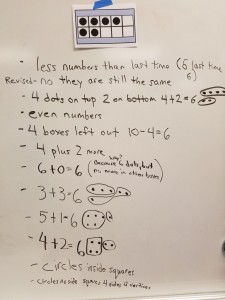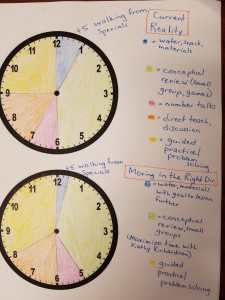
It’s been interesting to see the growth in students this year in using Number Talks. Right now, the team is trying to encourage students to subitize and decompose numbers into its parts with ease. With this in mind, we are using ten frames to show numbers in several ways. For this segment, we have shown the number 6 in a ten frame and have now shown the same quantity in a different manner. This will be done a couple of more times with the number 6, though not necessarily in consecutive days. The first student to speak looked at what I had written about there being less dots this week than last week (I was out sick earlier this week), then as he read his statement, he said, “No, wait” and raised his hand to revise his statement. Last week the top row was full with one dot on the bottom row. Some students are still wanting to get creative with the math sentence, such as “13 – 7 = 6.” I usually ask them if that’s what they notice about the image and they will shake their heads and continue looking. Some students are eager to show 1 finger that they have a method, willing to stop there, while other students immediately have 5 or 6 fingers held to their chests to compete with how many methods they have found to explain the math image. However, they are growing. The students now know to expand on what they see with a math sentence. Perhaps this isn’t something I should ask? If a student notices 4 and 2, I’ll ask the student to come up to the board to show exactly how he/she saw 4 and 2 and explain how this would be described in a math sentence. Though, one student did look at the ten frame from a geometry perspective, I didn’t consider it a frustration since it’s one of our current spiral review objectives :).
What’s next?
I’d like to move towards the students talking to one another, asking questions, expanding or supporting one another’s statements. However, right now there is interest in different perspectives and aha moments in spotting a new way to view numbers. Also, some students aren’t sold on participating yet. I’m hoping this will come with time. Lovin’ it.
Monthly Archives: September 2016
Classtime Velocity – Is Our Time Moving Us in the Right Direction?

* Add 10 minutes to the yellow as our time moves beyond 1 hour and 5 (as noted) to the blue. Students return to my room after Recess and Specials back to back. They tend to be hungry and thirsty, leading to my decision to switch my snack to the afternoon, rather than the typical morning snack. Between this and a water break, I noticed some waste of learning time. Ouch! We also begin our Math block with Conceptual Review rather than ending with review. If the review went with a new game and I hadn’t taught it the day before, I gave a quick model – again wasting time so begins ideas to improve my math block. I will return to morning snack, plus model the game/review prior to the math block, either in the morning before 8 or the day before. I also noticed that Conceptual Review has time that can be given to Guided Practice, but I really need to maximize the block I’m going to shorten. Because I went to a Kathy Richardson workshop this past summer, I will blend review time, inserting her program with the goal of strengthening number sense. I’ve not used her games yet. According to our Kindergarten and First grade teams, this program is excellent without being lengthy.
New goals – reduce wasted time and giving more time to Guided Practice. Within this increase learning in Conceptual Review by incorporating a fun, effective program.
As I looked at my clock, keeping in mind Andrew Stadel’s advice to make the 20% of what we use help out 80% of what we need, I tried to think of my year end goals for my students and I fall back to number sense. Since Kathy Richardson is designed for this and doesn’t veer away from my goal of bringing curiosity into the room, then this should help as I move my students in a better direction for learning, with time well spent versus time used up.
